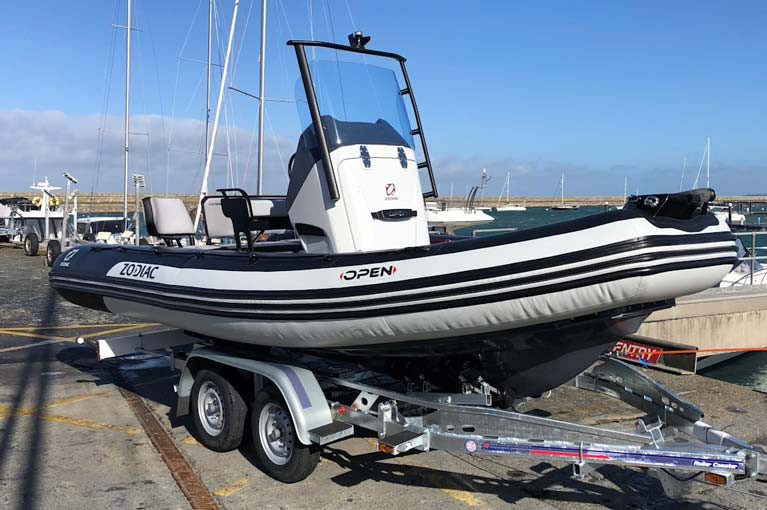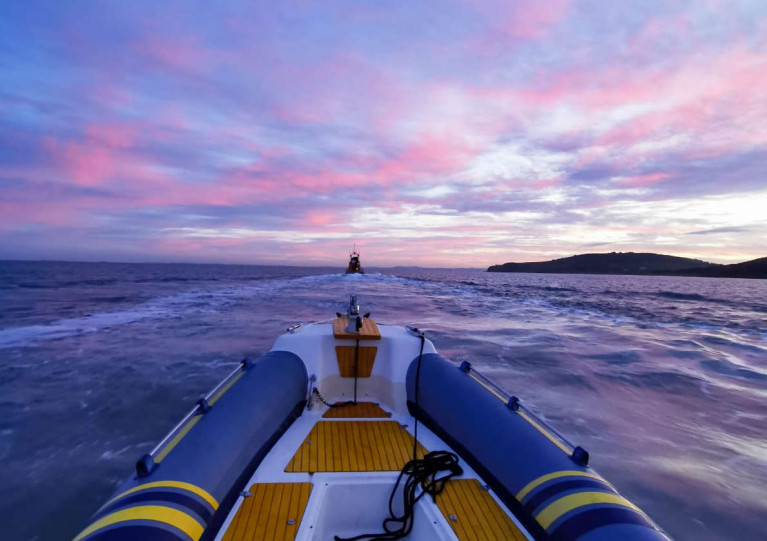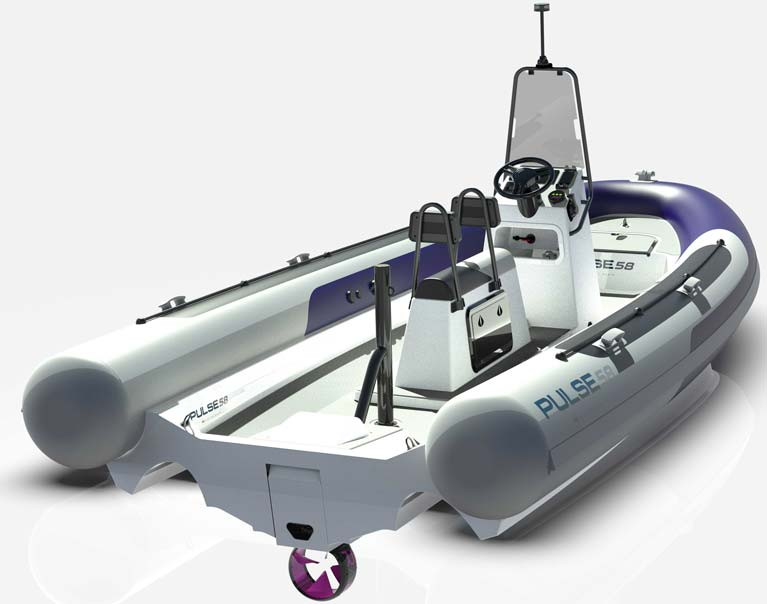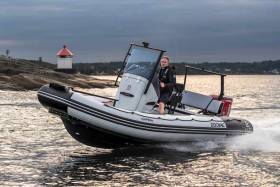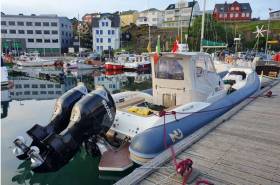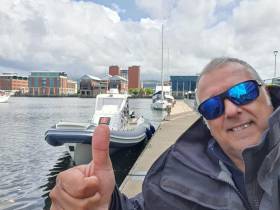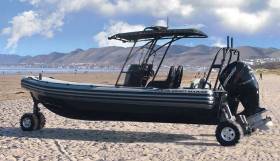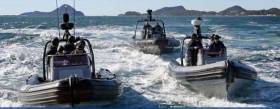Displaying items by tag: Rib
MGM Boats describes the new Zodiac Open 5.5 that has recently landed at the boatyard in Dun Laoghaire Harbour as the 'Swiss army knife of boats'.
As regular Afloat readers will know, MGM Boats became Irish Zodiac distributors last December. In announcing the new distributorship, Dublin Bay-based MGM Boats also launched a promotion on the new Open 5.5 metre RIB, a popular size model in Ireland and this March arrival makes good on that promise.
With its excellent sea-keeping performance – thanks to its deep V-hull and its optimised deck plan, the Open is a great starter package and a lot more besides because it is pretty much at ease in all activities.
Thanks to its design, it is easily transportable, even with an inflated tube, it works for getaways, fishing, waterskiing, wakeboarding and sunbathing (we hope!)
The new 5.5 has a Deep V fibreglass hull and a self-bailing deck. Full spec here.
More details from MGM Boats here.
Book Now For Powerboat Training At The RSGYC
Places are still available for the latest powerboat training course at the Royal St George Yacht Club later this month.
The two-day course, on Saturday 29 February and Sunday 1 March from 8.45am to 5pm, provides the ideal way to get afloat for the first time, or to build on skills you already have.
The Irish Sailing syllabus Powerboat II course (National Powerboat Certificate) will formally teach you the fundamentals in the safe operation of a powerboat, its preparation and allied aspects, while helping you to build your confidence on the water and get the most from your RIB or powerboat in a safe and comfortable manner.
This weekend course (which will also run in May) is priced at €260 which includes all course materials, instruction and certifications. Book online via the RSGYC website HERE.
Larne Lifeboat Assists Three On RIB With Engine Problems
Larne RNLI launched at 3.50pm on Saturday (18 January) to assist a RIB which had lost engine power half a mile south of Muck Island.
The volunteer crew were requested to launch by Belfast Coastguard to the nine-metre RIB with three people on board which had been losing engine power.
The all-weather lifeboat, Dr John McSparran, launched into a slight swell with light levels decreasing as the night closed in.
The lifeboat reached the anchored casualty boat and a volunteer crew member was put on board to establish a tow rope so that the lifeboat could bring the casualty boat into Carrickfergus Harbour.
One of the casualties from the boat was transferred to the lifeboat for some respite from the cold conditions of the open water.
Upon reaching Carrickfergus, the casualty boat was handed into the care of the Portmuck Coastguard team.
Larne RNLI lifeboat operations manager Allan Dorman said: “The casualty boat did the right thing by dropping their anchor and calling for help at the earliest opportunity.
“Being able to find the boat in daylight made it much easier for our volunteer crew to establish the tow and bring them into the safety of Carrickfergus Harbour.”
RS Launch Electric RIB at Boot Dusseldorf
RS Electric Boats, the brand-new sister company to RS Sailing, this week launches the Pulse 58 - its electric RIB. Unveiled at Boot Dusseldorf, the Pulse58 is the product of two years of development and is ground-breaking as the first-ever production RIB with a fully integrated electric drive.
The marine industry trails behind car manufacturers in terms of engine emissions and a defined future for alternative energy. Evolving environmental attitudes and imminent changes to law around the world are driving demand for a different approach to boating that removes the negative impact of a fossil fuel burning motor.
With 25 years of design and build experience in zero emissions boating, RS’ Pulse58 will blend proven automotive electronic technology and an extremely efficient electric drive optimised hull form, with the highest level of sustainable construction of any boat in its sector.
Project managed by the award-winning RS development team alongside key industry experts, Pulse58 uses marinized electronic components already well proven in automotive use. A 57Kwh battery bank stored in a purpose designed underfloor structural case delivers up to 104v to the ground-breaking RAD drive propulsion unit. RAD drive is a unique and integral retractable drive unit that belt feeds power from the twin motors to a hub-less drive unit. The electronic management system controls all aspects of the drive, motor control and battery conditioning and also controls the electric drive tilt mechanism that lifts the RAD drive into the transom in shallow water.
Pulse58’s hull design has been purposely designed for its electric drive. The tunnel hull form and long waterline length give decreased low speed drag that suits the instant torque of electric power, while providing a stable and maneuverable platform at speed. The battery bank deep in the hull lowers the centre of gravity increasing comfort. Hypalon tubes and an integral cockpit non-slip floor combine to give a high quality and long-lasting finish. The acclaimed Raymarine Axiom 7” touch screen display is standard fit on the console. Alongside all the advanced plotting and navigation features, Axiom also displays the power reserve, instant range and battery data delivered by the RADLink transmitter. RADLink then broadcasts by Bluetooth and 4G to its mobile app to give remote charge data along with revolutionary geofencing capabilities to control security and safe use.
Pulse58’s sustainable construction comprises of Bio-based infused epoxy resin, recycled PET core material and naturally sourced basalt and flax fibres. These fibres are incredibly strong and energy absorbing. Experience gained in the sustainable construction of the successful RS Aero and RS21 sailboats has enabled RS to bring to market the most sustainable laminate of any RIB in the sector. This innovative laminate is lightweight and long lasting in even the most extreme environments.
Pulse58 debuts at Boot Dusseldorf on Saturday 18 January - 16:30 (CET) - Hall 15 – Stand E24.
MGM Boats Is New Irish Zodiac RIB Distributor
Top Irish boat dealer MGM Boats has added the Zodiac Inflatable and Rigid Inflatable Boat marque to the range of boats offered at its Dun Laoghaire Harbour showrooms.
In announcing the new distributorship, Dublin Bay-based MGM Boats has launched a promotion on the new Open 5.5 metre RIB, a popular size model in Ireland.
The new 5.5 has a Deep V fibreglass hull and a self-bailing deck. Full spec here.
More details from MGM Boats here.
RIB Adventurer Sergio Davi is Between Iceland & Greenland
The fascinating adventure of RIB skipper Sergio Davì continues alone in the most extreme and difficult part of his bid to complete an ‘Ice RIB Challenge’ from Palermo to New York.
Since his departure from Palermo about a month ago, Sergio Davi in his Nautilus Explorer RIB called to Dun Laoghaire and Belfast in July and has already covered more than 3,500 nautical miles of the 7,000 planned.
In recent weeks he reached the Faroe Islands, where he was a guest of the Torshavn Marina, and Iceland, where he was received by the Snarfari Marina of Reykjavik and representatives of the Peace Run of Iceland.
The stop in Reykjavik was important because, as scheduled, he carried out the second pit-stop by lifting up the boat, cleaning the hull, checking the engines with oil change and filters before continuing with the second half of the journey.
Currently Davì, on board of his Nautilus Explorer, is sailing through the “Denmark Strait”, that’s to say the oceanic waters separating Iceland from Greenland.
At Tasiilaq (also known as Assamalik), first Greenlandic port of call, Sergio Davì is waited for by the Italian explorer Robert Peroni, who has crossed Greeland by foot several times. After Tasiilaq he will have a stop in the small town of Qaqortoq, south of Greenland, and then on to Canada.
Solo navigation involves many difficulties. It is very tiring both physically and mentally. It is impossible to be able to rest and there can be no distraction or loss of concentration. A hard test to which Davì seems to respond with excellent results.
The technical-logistic support offered by the partners of the Ice Rib Challenge is also fundamental: as we know Davì is carrying out this adventure on board a totally standard RIB (rigid inflatable boat) branded Nuova Jolly Marine model Prince 38cc, powered by two outboard engines Suzuki DF350A dual prop, with only few adjustments to make suitable the navigation at extreme latitudes. Thanks to the special nautical tent made by Toti (nautical upholstery) and the special pilot seats created by Besenzoni, the captain can face difficult sailing hours, sheltering from rain, wind and cold. Moreover, thanks to the use of Amphibious bags (dry equipment), all equipments and personal goods are protected from bad weather and temperature changes.
Since his departure from Palermo about a month ago, Sergio Davi in his Nautilus Explorer RIB has already covered more than 2,500 nautical miles of the 7,000 planned to complete his ‘Ice RIB Challenge’ from Palermo to New York.
The long-distance veteran has already crossed the Bay of Biscay and been welcomed by the Port de Camaret-sur-Mer, on the west coast south of Brest, with his Nuova Jolly Prince 38cc inflatable boat, powered by two Suzuki DF350A outboards.
More recently, his departure from Lochboisdale in the Outer Hebrides of western Scotland has completed his round of stopovers in these isles supported by Suzuki GB, which saw Davi welcomed at Newlyn Harbour in Cornwall as well as by the Royal Irish Yacht Club in Dun Laoghaire and Belfast Harbour Marina.
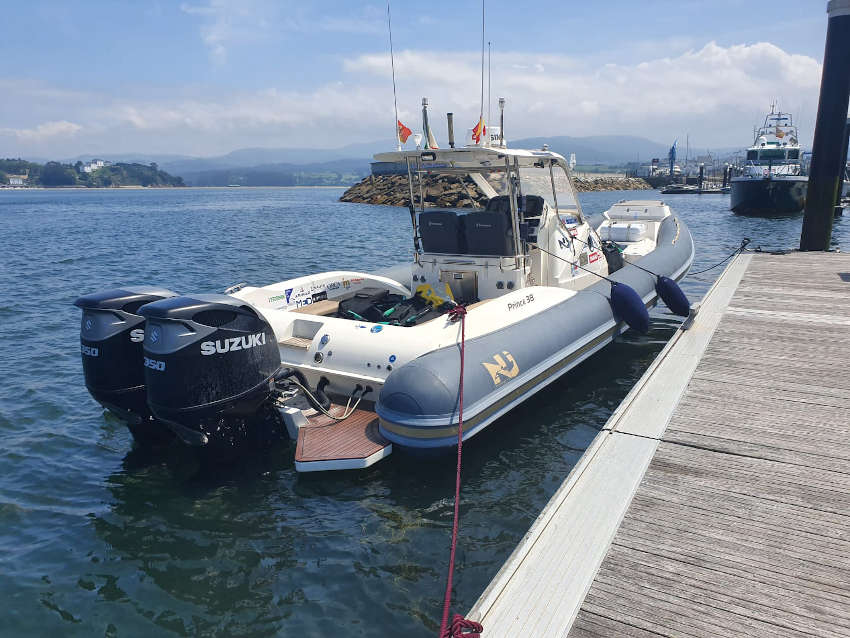
His stop in Dublin Bay was particularly exciting as he was greeted on arrival in Dun Laoghaire by a representative of the Italian Embassy relaying the personal greeting of Ambassador Paolo Serpi, and journalist Concetto La Malfa from italvideonewstv.net, an Italian online magazine in Ireland. While in Dublin, Davi also met Ambarish Keenan, a representative of the Peace Run movement.
Yesterday the Nautilus Explorer was making good progress to Torshavn in the Faroe Islands, where it was expected yesterday evening (Saturday 27 July). This is a key refuelling stop before the big push across the far North Atlantic to Iceland.
The crossing will be an important test both for the boat and engines and also for the equipment that the captain has brought with him.
Keep up with Davi’s Ice RIB Challenge at his website www.ciuriciurimare.com or via social media, on Facebook at Sergio Davi Adventures and Instagram @sergiodavi_adventures. In addition you can search for ‘Sergio Davi’ in the iOS Ap Store and Google Play Store for the official app to follow in real time.
Big Military Zodiac RIB Visits Cork Harbour
Cork Harbour had an impressive RIB visitor when a Zodiac Hurricane ZH-1300 MACH II OB Interceptor called to the south coast earlier this month writes Bob Bateman
The new model is the newest and largest platform of the Zodiac Hurricane range and had its world debut in 2017.
Spotted on board on her harbour tour was Crosshaven RNLI's James Fegan and his wife Caroline.
Also invited onboard in Cork Harbour were members of Mallow Search and Rescue who, according to its Facebook page, travelled to the Harbour's Naval base for a demo day with Zodiac Milpro.
Dubbed the Interceptor, the ZH-1300 demo boat shows the nimble manoeuvrability normally associated with smaller craft and, say Zodiac, it addresses the needs of end users in the Military and Patrol boat market for larger platforms, with focus on speed, handling and stability.
 This 13-metre platform is propelled by quad (4x) Mercury Verado 350 HP outboard engines
This 13-metre platform is propelled by quad (4x) Mercury Verado 350 HP outboard engines
The boat is designed around an aluminium hull and deck and features the 'MACH 2' stepped-hull design.
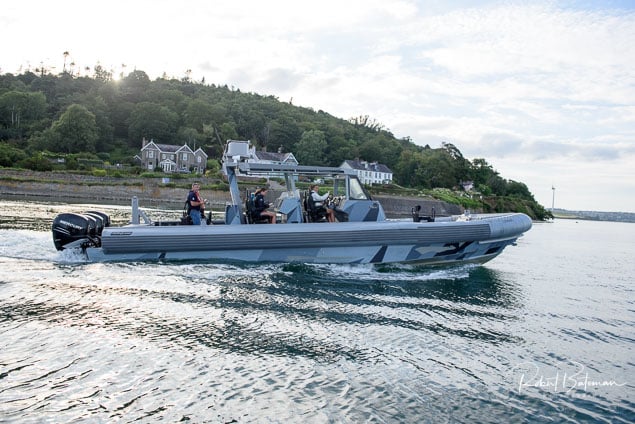 The ZH-1300 OB is fitted with a dual console, featuring a pilot and navigator in the forward positions, and communication and team commander positions at the aft console, all with drop-down, shock-mitigation seating
The ZH-1300 OB is fitted with a dual console, featuring a pilot and navigator in the forward positions, and communication and team commander positions at the aft console, all with drop-down, shock-mitigation seating
Based on proven 9- and 11-meter MACH II hull models, the larger size allows for higher payloads and additional deck space, while providing superior seakeeping and higher speed capability in rough water conditions.
The patented Hybrid shaped collar features round sections at the bow and D-shape sections in the aft two-thirds, while the Durarib™ patented foam and air technology design provides exceptional strength and impact resistance. The collar is also equipped with an auto-inflation system and integrated dive door.
Specialised Four-Wheel Drive RIB for All Wales Boat Show
A James Bond-style amphibious craft that uses four-wheel drive to enter and leave the sea will be making its European debut in North Wales.
The £220,000 AMP rib will be among the stars of the All Wales Boat and Leisure Show at the Anglesey Showground from Thursday, May 30, to Saturday, June 1.
It is being brought there by Pwllheli and Southampton-based Ideal Boat who have designed bespoke versions of the high-powered vessel with Ocean Craftmarine who specialise in making rigid inflatables for the military and law enforcement agencies worldwide.
Ideal Boat will also be showcasing some of their other impressive brands like Chaparral, Finnmaster, Husky, Robalo, Spectre and Capelli.
According to managing director Neville Williams, 44, who founded the company in 2012, they have been crowned international dealer of the year by American boat makers Chaparral every year since 2014.
He said: “Chaparral is a fantastic company. They are the biggest selling, number one sports boat brand in the UK & USA, and I am very proud that outside the USA we are their biggest and most successful dealer.
“This year we will be unveiling our new brand, AMP, which is a collaboration with Ocean Craftmarine. Their parent company Solico also produces 90 per cent of the world’s snowboards and wakeboards.
“They’re amphibious ribs with wheels on legs that drop down and they drive out of the sea and straight up the beach.
“Most of their marine products are made for the military and special services, as well as for navies worldwide.
“We gave them a specification and they have made different versions of the AMP for us, ranging in price from £156,000 to £300,000 including VAT.
“It’s a quality rigid inflatable boat with seating that can cope with bad seas if necessary and has an onboard 35 horsepower Vanguard engine as well as the 4wd hydraulic legs which enables you to drive on dry land. It’s very James Bond, it’s very glamorous and a lot of fun.
“The AMP will be making its first-ever appearance anywhere at the All Wales Boat and Leisure Show.
“Although they have not arrived in the country yet, I have a number of them already sold, so I am expecting them to be very popular.
He added: “The All Wales Boat and Leisure Show is a great event and the Anglesey Showground is the perfect location.
“It’s bang in the middle of Anglesey, its surrounded by holiday parks and the sea. That’s why people go there. You’ve got your audience there and it’s going to be the school holidays.”
Organiser Davina Carey-Evans, managing director of Beaumaris-based Sbarc Event Management, revealed the marine sector is growing faster in Wales than any other part of the UK and boating generates an annual tourism spend of £282 million.
Anglesey is also popular with surfers and scuba divers, who pump £7.8 million into the local economy.
Davina, who has previously been involved with marine events such as the One Ton Cup, a world-renowned sailing event which was based in Pwllheli in 2001 and the annual Round Anglesey Race, said: “The All-Wales Boat Show has evolved and grown and the 2019 event will also include a strong leisure element, with holiday parks like The Warren in Abersoch and Plas Coch on Anglesey being represented.
“Moving the show to Anglesey showground will hopefully be a catalyst for our plan to turn the island into a major events hub.
“We certainly have all the right ingredients. Anglesey is already a destination for 1.8 million visitors every year looking for things to see and do while, the venue is ideal, with 3000 square metres of undercover buildings, parking for 3,000 vehicles and excellent accessibility as it’s just off the A5 and A55.
“The show will connect together industry leaders in boat and leisure products and services across Wales, with not only fishing and boating enthusiasts but all those that have a passion for the great outdoors. T
“It will be a family friendly and an engaging event with the opportunity to discover a huge range of exhibitors, show events and activities where you can have a go too.
“The show will be a must-visit for event boat owners, watersport-lovers or families looking for a great day out and there is also a glamping site for those who want to stay overnight.”
The event also has the backing of Jim Jones, the managing director of North Wales Tourism.
He said: "Maritime tourism is on the up here because North Wales generally and Anglesey specifically has so much to offer. It's second to none.
“We already have fantastic attractions on the Menai Strait, including RibRide and the brilliant facilities at the National Outdoor Centre for Wales, Plas Menai, which excels in delivering the ultimate in water sports courses and outdoor adventure activities.
“North Wales is undoubtedly the European capital of adventure tourism and marine tourism is a big part of that.
“There is so much confidence in the industry, so much investment going into North Wales, and we're now reaping the rewards.
“The plan to stage the All-Wales Boat and Leisure Show at the Anglesey Showground heralds another economic boost for the region and underlines that we are now in a golden age for tourism.”
Gemini RIBs Appoints Berthon as Sole UK & Ireland Dealer
South African Rigid Inflatable Boat (RIB) builder Gemini Marine has announced Berthon as its sole UK and Ireland dealer for its range of military, rescue, commercial and leisure RIBs.
Established in 1979, Gemini Marine designs and manufactures the most comprehensive range of cabin and open RIBs for many of the world’s military, rescue and commercial operators, as well as supplying RIBs into the leisure, expedition and adventure sectors. These customers all recognize the resilience, reliability and durability of Gemini RIBs in even the most extreme and dangerous operations.
“We are thrilled to be appointed to represent the Gemini RIB range in UK and Ireland. Berthon has long been involved in both the leisure and commercial boat market, and we are now offering the Gemini product to all our customers. With customisations which we will carry out in our Lymington shipyard, we can take a standard product and make it suit every customer’s unique requirements. Gemini’s comprehensive range of RIBs and inflatables neatly fills the gap in our product portfolio,” said Dominic May, Director of Berthon.




























